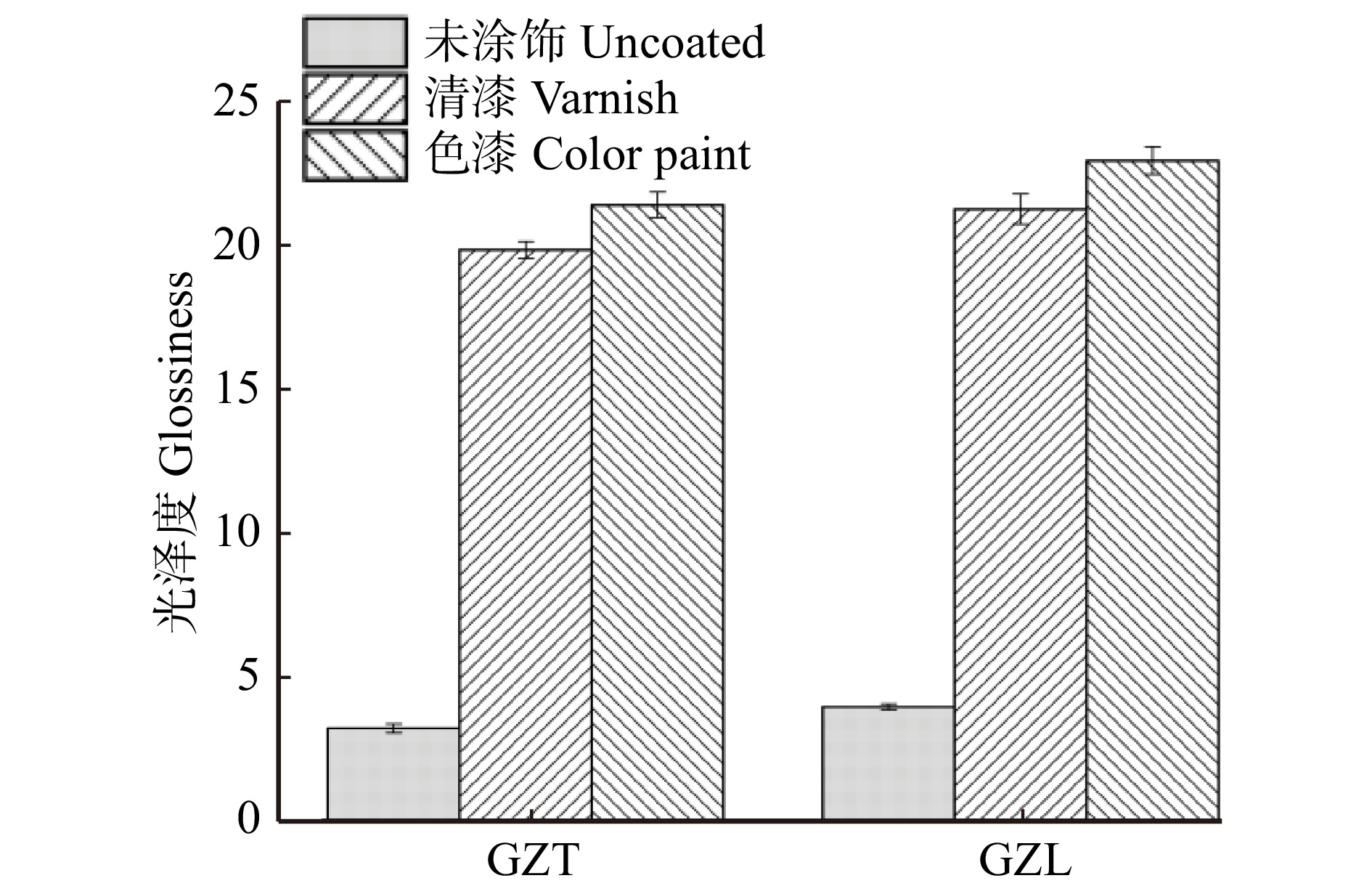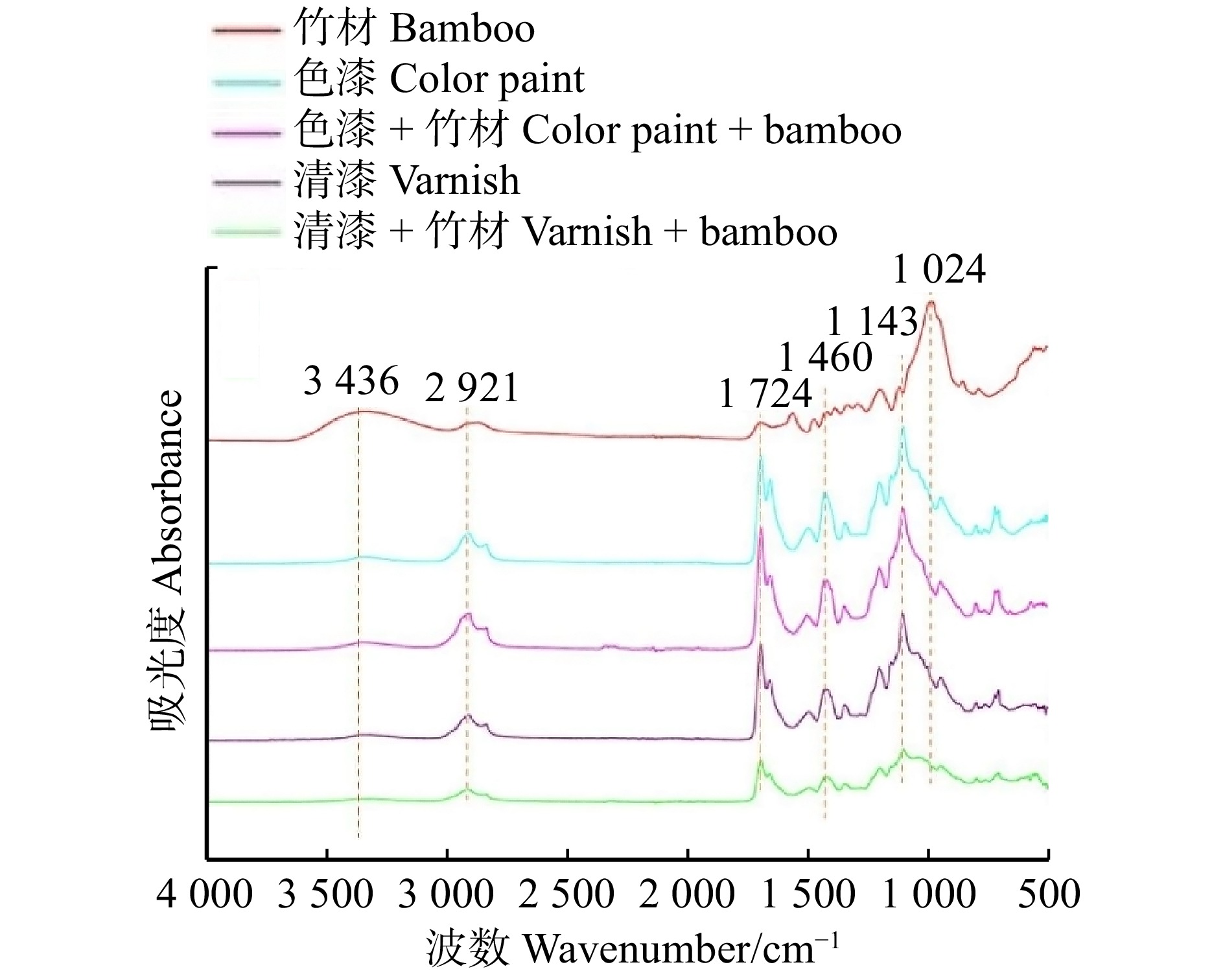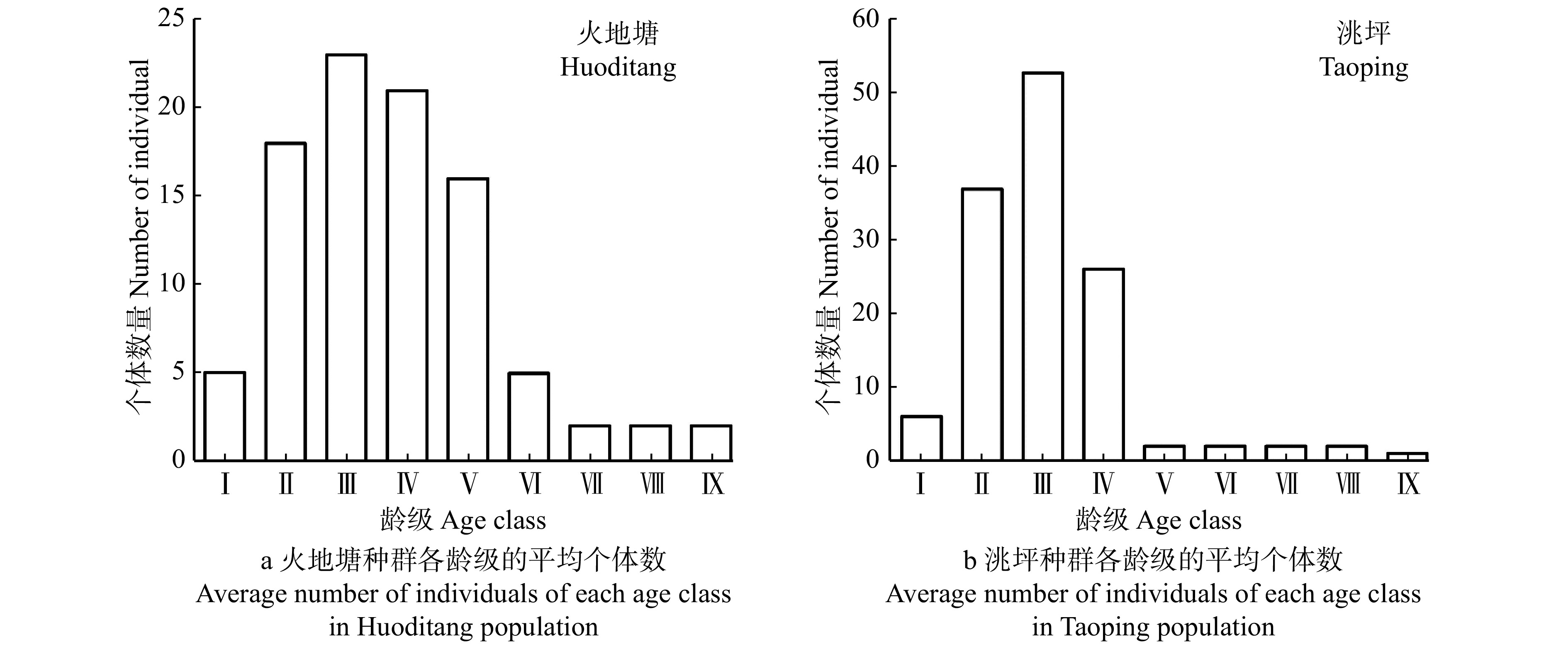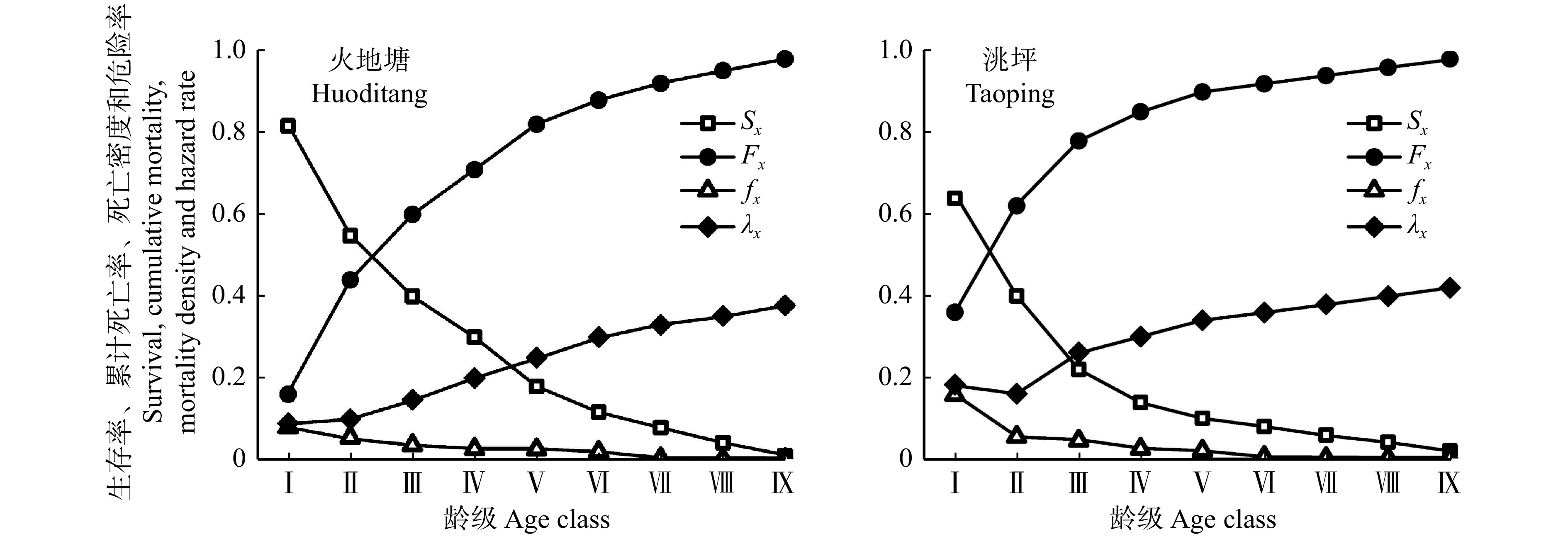Structure and dynamic characteristics of Betula albo-sinensis populations in two regions in the Qinling Mountains of northwestern China
-
摘要:目的 红桦是我国特有的桦木科高大落叶乔木,也是我国暖温带森林主要建群种之一,具有观赏、经济和生态价值。通过对秦岭两地区红桦种群结构与动态特征研究,阐明红桦种群年龄结构特征及种群数量动态变化,建立种群发展预测模型,揭示红桦种群自然更新障碍原因,为今后红桦种群的保护和恢复提供理论依据。方法 对陕西省宁陕县火地塘林场和甘肃省礼县洮坪林场红桦种群调查与统计,绘制红桦种群静态生命表,分析种群年龄结构及数量动态变化,建立种群发展预测模型,同时结合种群动态数量化法和数量时间序列分析法揭示红桦种群的发展趋势。结果 两地种群年龄结构均在Ⅲ龄级时个体数最多,种群主要由幼龄个体组成;两地种群均是前期先衰退后增长,中期短暂衰退后增长,在Ⅵ ~ Ⅶ 龄级急剧衰退;洮坪种群比火地塘种群更早进入衰退期,其种群更易受到环境因子的影响;两地红桦种群的存活曲线都趋向于Deevey-Ⅱ 型。结论 火地塘和洮坪两地红桦种群的年龄结构均呈不规则的金字塔型,种群发展主要靠中老龄个体维持;两地红桦种群现阶段都为增长型种群,且都对生境因子具有较高的敏感性,洮坪种群尤为明显;在未来两地红桦种群均不同程度地缺乏幼苗,自然更新较困难。针对此问题,提出保护和恢复红桦种群的策略:人工培育幼苗移植到种群的林窗内;对幼龄林采用“3年5次”的抚育方式,对中龄林采用整枝、修剪、除灌等方式进行抚育;对于郁闭度达0.9以上的林分,适当间伐,每公顷保留1 500株左右,提高种群的自然更新能力。Abstract:Objective Betula albo-sinensis, a tall deciduous tree of the Betulaceae, unique to our country, is one of the main constructive species of warm temperate forests in China, with ornamental, economic as well as ecological values. Through the research on the structure and dynamic characteristics of red birch populations in two regions in the Qinling Mountains of northwestern China, clarifying the age structure characteristics and population dynamic changes, establishing the population development prediction model, and revealing the reason for the natural regeneration obstacle, we provided a theoretical basis for protection and restoration.Method The two B. albo-sinensis populations in Huoditang Forest Farm (Ningshan County, Shaanxi Province) and Taoping Forest Farm (Li County, Gansu Province) were investigated and counted. Then the static life table was drawn, the population age structure and quantitative dynamic changes were analyzed, and a population development prediction model was established. Meanwhile, the development trend was revealed by the population dynamics quantification method and quantitative time series analysis method.Result The age structure of the populations in the two regions was the most individuals at age Ⅲ, and the populations were mainly composed of young individuals. They both first declined and then increased in the early stage, then increased after a short decline in the middle term, and sharply dropped off at the age of Ⅵ−Ⅶ . The Taoping population was more susceptive to environmental factors, entered the decline period earlier than the Huoditang population. Their survival curves tended to be the Deevey-Ⅱ type.Conclusion The age structure of the B. albo-sinensis populations in Huoditang and Taoping both presents irregular pyramids, and the population development is mainly maintained by middle-aged and elderly individuals. They are both growing populations at the current stage and highly dependent on habitat factors, especially obvious for Taoping. In the future, natural regeneration would be untoward for them because of lacking seedlings to various degrees. In response to these problems, several strategies to protect and restore: artificially cultivate seedlings and transplant them into the gaps of the populations; adopt the “5 times in 3 years” tending method for young forests, and the pruning, pruning, mowing, removing irrigation and the like for middle-aged forests. As for stands with a canopy density of more than 0.9, appropriate thinning is required to keep about 1 500 plants per hectare to improve the natural regeneration capacity of the populations.
-
竹材具生长周期短、硬度强、韧性高、可降解的生物性材料。且在现有木材资源不能适应家具产业发展迫切需要的情况下,竹材是取代实木的最理想材料[1],竹集成材作为保持了竹材优异的物理力学性能的竹制家具用材,具有良好的发展前景。众所周知,竹材容易受外界环境如光照、水、微生物等的侵害而发生变色、腐朽[2],竹集成材亦如是。对竹集成材进行表面涂饰是最能够有效保护其性能的方法之一。
以水作为溶剂的水性漆与传统油性漆相比,不含挥发性有机物(volatile organic compounds,VOCs),具有绿色环保、节约资源的特性[3]。伴随着国家环保政策的不断完善和绿色环保理念的普及,水性漆在家具、室内装饰、建筑等领域将逐步替代传统涂料[4]。然而竹集成材水性漆涂饰面临着竹集成材密度大,纹孔少,横向渗透困难等问题[5],使得水性漆漆膜附着力差,竹集成材水性漆涂饰工业化进度缓慢。为了克服这些问题,Lu[6]通过对毛竹表面进行过氧化氢表面预处理的方法,提高了水性漆在毛竹表面的附着力。此外其他研究人员通过使用湿热处理[7-8]、碱液浸泡处理[9]等方法,也在一定程度上提高了竹材表面的润湿性和粗糙度,改善了水性漆等流体在竹材内部的渗透效率,漆膜的附着力由此增强。涂饰工艺对涂料性能的发挥有着重要影响,是涂饰过程中的关键技术环节。但目前有关水性涂饰工艺的研究还着重于水曲柳、杨木等木质材料上[10-12],对竹集成材涂饰工艺研究较少,且未有水性清漆和色漆对竹集成材硬度、附着力等漆膜性能影响方面的研究。
为了解决竹集成材水性涂装这些难题,本研究以家具中最为常用的毛竹集成材为基材,在省去预处理的基础上优化了竹集成材水性涂饰工艺,提高了水性涂饰工艺的效率,系统地探究了竹集成材清漆与色漆涂饰性能的影响及竹集成材水性漆漆膜的附着机理,为竹家具的水性化涂装提升提供理论支持和科学依据。
1. 材料与方法
1.1 材 料
选取含水率为11%的毛竹集成材,制成尺寸为100 mm(长) × 100 mm(宽) × 10 mm(厚)的试样18块,并对试样在室温和湿度为(65 ± 3)%的环境下进行打磨。选用涂料为自制水性底漆和商业水性面漆(分为清漆与色漆两种类型,主要成分为水性聚氨酯树脂,底漆固体含量为39.2%,面漆固体含量为34.6%)。
1.2 基材涂饰
依次用80目、120目、180目和240目砂纸对基材进行顺纹打磨并用羊毛刷除尘。涂饰前底漆与面漆分别添加5% 和8%的去离子水进行调配。调配底漆涂布量为80 g/m2,面漆涂布量为120 g/m2,在室温下均匀地喷涂底漆3遍、面漆1遍,每遍喷涂干燥之后再次顺纹打磨1遍(图1)。涂饰完后基材后在室温下干燥8 h。
1.3 测试方法
将无差别的18个样品分为A、B和C这3组,每组6个,按照字母加数字的方式编号成A1 ~ A6、B1 ~ B6和C1 ~ C6。
1.3.1 漆膜硬度、附着力、光泽度测试
选取A组试样进行漆膜的硬度测试。根据ISO 15184—1998 《色漆和清漆 铅笔法测定漆膜硬度》标准测试。选取B组试样进行漆膜的附着力测定。根据ISO 2409—2013《色漆和清漆交叉切割试验》中的检测标准,按照规定的步骤,使用QFH漆膜划格仪依次对每个试样进行测定。参照ISO 2813—2014《色漆和清漆在20°、60°和85°非金属色漆漆膜镜面光泽的测定》使用60°光泽度仪对C组和对照试样进行光泽度测试。
1.3.2 表面粗糙度测试
参照GB/T 12472—2003《产品几何量技术规范(GPS) 表面结构 轮廓法 木制件表面粗糙度参数及其数值》,使用TR240便携式表面粗糙度仪测试试样的表面粗糙度,将触针的运动转变为电信号,测量出各粗糙度参数。设置取样长度为2.5 mm,为了提高准确率,在每一块试件上选取4 个点测试,并对测试结果进行记录。
1.3.3 色度值测试
使用SP60色差仪按照国际照明委员会CIE标准色度系统对C组试样基材涂饰前后的颜色变化进行定量的度量。CIE由L*、a*、b*这3个数值进行评估。L*表示亮度;a*表示红绿,数值变化由正到负,表示颜色从红(正)到绿(负);b*表示黄蓝,数值变化由正到负,表示颜色从黄(正)到蓝(负)。总色差值ΔE表示颜色知觉差异,数值越小则表示颜色变化越小。ΔE由公式(1)确定:
ΔE=√ΔL∗2+Δa∗2+Δb∗2 (1) 式中:ΔL*、Δa* 和Δb*分别为涂饰前后的L*、a*和b*差值。
1.3.4 扫描电镜(scanning electron microscope,SEM)分析
使用场发射环境扫描电镜(FEG-ESEM,XL30ESEMFEG,FEI Company,USA)观察并记录基材涂饰前后的表面形态。将加速电压设置为7 kV后,着重对涂饰后基材与漆膜界面结合处的形态进行观察。
1.3.5 傅里叶变换红外光谱(Fourier transform infrared spectroscopy,FTIR)分析
用溴化钾压片法分别测定涂饰前后试样的FTIR。设置光谱分辨率为4 cm−1,在500 ~ 4 000 cm−1范围内,利用傅里叶变换红外光谱仪(Nicolet6700傅里叶红外光谱仪,Thermo Scientific, Waltham, USA)扫描得到清漆、色漆、竹集成材、清漆和色漆涂饰后的基材的5种FTIR。测试完成后,将所有5个样品的光谱绘制成图表,分析每个样品的特征峰的变化,并据此探究水性漆与竹集成材的结合机理。
2. 结果与讨论
2.1 漆膜硬度与附着力
漆膜硬度代表了涂饰在基材上的漆膜的机械强度,反映了漆膜对来自外界的碰擦、刺划等机械作用的耐受能力[13]。从表1可以看出:清漆的漆膜硬度为1H,而色漆的漆膜硬度为2H。这是因为漆膜的硬度是由成膜物质的性能所决定的,色漆中含有较高硬度的颜料,因而色漆的硬度优于清漆。但两者的硬度均能够满足GB/T 3324—2017《木家具通用技术条件》中室内装饰、实木地板的使用要求[14]。此外,我们发现清漆和色漆的漆膜硬度均比之前研究的水性漆涂饰水曲柳所得的硬度高[12],这充分说明了水性漆采用喷涂的涂饰工艺能在竹集成材上产生能媲美在木材上的效果。
表 1 水性漆漆膜的硬度与附着力Table 1. Hardness and adhesion of film of waterborne paint清漆 Varnish 色漆 Color paint 试件 Sample 硬度 Hardness 附着力 Adhesion 试件 Sample 硬度 Hardness 附着力 Adhesion A1 1H 0级 Grade 0 B1 2H 1级 Grade 1 A2 1H 0级 Grade 0 B2 2H 1级 Grade 1 A3 1H 0级 Grade 0 B3 2H 1级 Grade 1 A4 1H 0级 Grade 0 B4 2H 1级 Grade 1 A5 1H 0级 Grade 0 B5 2H 1级 Grade 1 A6 1H 0级 Grade 0 B6 2H 1级 Grade 1 平均值 Average value 1H 0级 Grade 0 平均值 Average value 2H 1级 Grade 1 漆膜附着力是指导家具涂装工艺优化方向的关键数据,也是影响漆膜性能的重要指标之一[15-16]。由表1可知:清漆漆膜的附着力比色漆漆膜的附着力更高,可达为最高的0级,这是由于色漆由于含有颜料,其固含量高于清漆,所以清漆具有更高的渗透能力,因而清漆能更好地填充在基材的细胞腔里。从SEM图中也能清晰地看到涂饰前后的差别。在未涂饰基材图(图2a、2b)中可以看到有较大的导管存在基材的横切面上,而纵切面上较多的则是裸露的细胞腔,基材表面裸露的细胞腔为水性漆在基材表面良好的附着性能提供了一定的基础。基材涂饰清漆和色漆后(图2c、2d),沟槽状的细胞腔和细胞胞间层中都有成膜物填充,因而达到较强的附着力。且从图2c、2d中也能看出:因清漆的渗透性能更好,使得在相同涂布量下,色漆的漆膜厚度明显高于清漆。此外,竹集成材水性清漆涂饰的漆膜附着力与之前研究的木材水性漆涂饰的附着力相当[12]。这也再次证明了使用“三低一面”的喷涂涂饰工艺能达到较好的漆膜性能。
2.2 光泽度
漆膜的光反射能力是通过漆膜的光泽度来衡量的,在一定范围内,随着竹材基材的表面光泽度增加,视觉效果变好[17]。涂饰前后基材的光泽度一般区分为垂直竹材纹理的光泽度值(gloss value of vertical bamboo texture,GZT)和平行竹材纹理的光泽度值(gloss value of parallel bamboo texture,GZL)。由图3可得涂饰后试样光泽度明显高于未涂饰试样,这是因为水性漆成膜物的光泽度比竹材自身的光泽度高。清漆涂饰后的平均GZT和GZL分别为19.83和21.24,色漆涂饰后的分别为21.39和22.93,均比未涂饰时提高了5倍以上,大大提升了竹集成材的装饰效果。且色漆因颜料填料含量较高,成膜物质在竹材表面固着占比更多,从而使得色漆光泽度均高于清漆。通过进一步对比发现试样的GZL均高于GZT,这是因为竹材大多数细胞是轴向排列的,在平行纹理方向,大部分细胞被剖开,细胞腔呈沟槽状暴露出来,因此成膜物容易填充到腔径大的细胞腔中;细胞壁的相对含量在垂直纹理方向上较多,因此成膜物很难渗透到具有纳米级孔的细胞壁中,导致平行纹理方向上成膜物的含量高于垂直纹理方向上的含量,因此其光泽度也显著增加[18-19]。
![]() 图 3 基材涂饰前后光泽度GZT为光泽度仪垂直于木材纹理方向时所测得的光泽度值;GZL为光泽度仪平行于木材纹理方向时所测得的光泽度值。 GZT is the glossiness value measured when glossmeter is perpendicular to the direction of wood texture. GZL is the glossiness value measured when glossmeter is parallel to the direction of wood texture.Figure 3. Glossiness of substrate before and after painting
图 3 基材涂饰前后光泽度GZT为光泽度仪垂直于木材纹理方向时所测得的光泽度值;GZL为光泽度仪平行于木材纹理方向时所测得的光泽度值。 GZT is the glossiness value measured when glossmeter is perpendicular to the direction of wood texture. GZL is the glossiness value measured when glossmeter is parallel to the direction of wood texture.Figure 3. Glossiness of substrate before and after painting2.3 表面粗糙度
表面粗糙度是指竹材在加工的过程中表面留下的各种不同程度的微观加工痕迹或不平度,常被用来评价竹材表面的质量,将会直接影响竹材的涂饰效果以及涂料的用量,常用轮廓算数平均偏差Ra、轮廓算数均方偏差Rq、微观不平度十点高度Rz和轮廓最大高度Ry表示[20]。本实验主要采用Ra表征试样的表面粗糙度,Ra的值越小,说明其表面越光滑平整。不同涂饰情况对应试样的表面粗糙度和电镜图见图4和图5。涂饰后的Ra值均小于未涂饰的Ra值,从SEM图也可以清楚地看出基材裸露的细胞腔被水性漆覆盖,表面粗糙度降低。且清漆涂饰后的Ra值比色漆涂饰后的Ra值小。这是因为色漆中含有颜料颗粒(图5b),可能影响成膜的交联程度,这导致涂饰色漆后表面粗糙度高于涂饰清漆后的表面粗糙度。
![]() 图 4 涂饰前后试样表面粗糙度平均值Ra为评定轮廓的算数平均偏差; Rz为微观不平度十点高度,是指在取样长度内5 个最大的轮廓峰高的平均;Rq为评定轮廓的算数均方偏差;Ry为轮廓最大高度,是指在取样长度内,轮廓峰顶线和轮廓谷底线之间的距离。Ra is the arithmetical mean deviation of assessed profile; Rz is the height of ten points of micro unevenness, which refers to the average of five maximum contour peak heights within the sampling length; Rq is the root mean square deviation of the assessed profile; Ry is the maximum height of profile, which refers to the distance between the contour peak line and the contour bottom line within the sampling length.Figure 4. Surface roughness of substrate before and after painting
图 4 涂饰前后试样表面粗糙度平均值Ra为评定轮廓的算数平均偏差; Rz为微观不平度十点高度,是指在取样长度内5 个最大的轮廓峰高的平均;Rq为评定轮廓的算数均方偏差;Ry为轮廓最大高度,是指在取样长度内,轮廓峰顶线和轮廓谷底线之间的距离。Ra is the arithmetical mean deviation of assessed profile; Rz is the height of ten points of micro unevenness, which refers to the average of five maximum contour peak heights within the sampling length; Rq is the root mean square deviation of the assessed profile; Ry is the maximum height of profile, which refers to the distance between the contour peak line and the contour bottom line within the sampling length.Figure 4. Surface roughness of substrate before and after painting2.4 色度值
色差是指两种颜色之间的差异。色差值是色差的数值表达。色差和色差值受涂料成分、涂饰工艺等因素的影响[21]。涂膜前后的色度值变化如图6所示。涂饰清漆前L*值为72.38,涂饰清漆后降低至64.37;a*值由原来的7.03增加到10.12;b*值由24.48增加到30.64。结果表明,涂层后基材表面明度略有下降,红色和黄色指数略有增加。ΔE较小为10.56,说明涂饰清漆前后竹集成材的表面颜色相差不大。这是因为水性清漆不含颜料,在竹集成材表面固化后是透明的,能较好地保持竹集成材本身的颜色。而涂饰色漆后L*值降低至34.74;a*值增加到12.03;b*值降低至18.30。说明涂层后基材表面明度有一定程度的下降,红色和蓝色指数略有增加。ΔE值较大,为38.46,这表明竹集成材表面的色彩特征因色漆中颜料的颜色发生了较大程度的改变。
2.5 FTIR分析
图7显示了各试样的FTIR,可以看出:3 436 cm−1处吸收峰是由−OH伸缩振动引起的,与其他谱线相比,竹材谱线在这一位置的峰值明显最强,且涂饰后色漆和清漆在1 724 cm−1处(C=O的拉伸振动特征峰)的强度分别较纯色漆与清漆小得多,在1 143 cm−1处(酯基中C−O伸缩振动峰)的峰值比竹材谱线的更强,说明水性漆中的极性分子(如羧基、羟基)与基材中的羟基结合后,水性底漆中的羧基与基材中的羟基发生了酯化反应,两者之间形成了氢键使结合更加稳固[22-23]。此外色漆在2 921 cm−1(−CH2反对称伸缩振动峰)、1 724 cm−1(C=O的拉伸振动特征峰)、1 460 cm−1(−CH2弯曲振动峰)、1 143 cm−1(C−O伸缩振动)处的峰值均比清漆所在的峰值高,这是由于色漆中相应的基团的占比比清漆中的高。所以水性底漆除物理结合外,还会与基材发生化学反应,使成膜物能很好地附着在竹集成材表面。
3. 结 论
本研究所获得的清漆的漆膜硬度为1H,色漆的漆膜硬度为2H。涂饰后,水性漆与竹集成材以机械互锁的物理形式和化学反应结合的形式使成膜物质能很好地附着在基材表面。由于色漆中含有颜料,清漆的附着性能优于色漆,可达最高的0级,与木材水性涂饰的附着性能相当。而颜料颗粒的存在影响了成膜的交联程度,使得色漆的表面粗糙度高于清漆。清漆和色漆涂饰后基材的光泽度提高了5倍以上,且平行纹理方向上的光泽度高于垂直纹理方向上。因色漆含有颜料,清漆涂饰前后总色差值较低,较好地保持了竹集成材本身优美的颜色。因此,本水性涂饰工艺在竹集成材上能获得较好的漆膜性能和较强的附着力,并能在很大程度上提升了竹集成材的装饰效果,为竹材及其制品的水性化涂装提供了重要的理论和技术支持。
-
图 1 红桦种群年龄结构
Ⅰ. DBH < 2.5 cm; Ⅱ. 2.5 cm ≤ DBH < 7.5 cm; Ⅲ. 7.5 cm ≤ DBH < 12.5 cm; Ⅳ. 12.5 cm ≤ DBH < 17.5 cm; Ⅴ. 17.5 cm ≤ DBH < 22.5 cm; Ⅵ. 22.5 cm ≤ DBH < 27.5 cm; Ⅶ. 27.5 cm ≤ DBH < 32.5 cm; Ⅷ. 32.5 cm ≤ DBH < 37.5 cm; Ⅸ. DBH ≥ 37.5 cm. 下同。The same below.
Figure 1. Age structure of Betula albo-sinensis populations
图 4 红桦种群生存率、累计死亡率曲线、死亡密度和危险率曲线
Sx. 红桦种群x龄级生存率;Fx. 红桦种群x龄级的累计死亡率;fx. 红桦种群x龄级的死亡密度;λx. 红桦种群x龄级的危险率。Sx, survival rate of Betula albo-sinensis population; Fx, fumulative death rate of Betula albo-sinensis population; fx, death density of Betula albo-sinensis population; λx, risk rate of Betula albo-sinensis population.
Figure 4. Survival rate, cumulative mortality rate, mortality density and hazard rate of Betula albo-sinensis populations
表 1 两地调查样地概况
Table 1 Survey of sample plots in the two regions
样地
Sample plot海拔
Elevation/m坡度
Slope/(°)郁闭度
Canopy closure红桦平均树高
Mean tree height of
B. albo-sinensis/m红桦平均胸径
Mean DBH of
B. albo-sinensis/cm伴生树种
Associated tree species火地塘
Huoditang2 000 ~ 2 200 8 ~ 15 0.80 9.90 ± 0.12 9.15 ± 0.03 灯台树、木姜子
Bothrocaryum controversum,
Litsea cubeba洮坪
Taoping2 100 ~ 2 600 12 ~ 23 0.85 11.12 ± 0.06 12.27 ± 0.16 荚蒾、蔷薇
Viburnum schensianum,
Rosa multifiora表 2 红桦种群动态变化指数
Table 2 Dynamic indices of Betula albosinensis populations
种群动态指数级
Population dynamic index动态指数
Dynamic index/%火地塘
Huoditang洮坪
TaopingV1 −62.50 −98.41 V2 −46.67 −40.00 V3 6.67 65.71 V4 64.29 86.11 V5 40.00 80.00 V6 66.67 0.00 V7 0.00 0.00 V8 0.00 0.00 Vpi 16.78 36.36 V′pi 0.93 4.00 Pmax 0.06 0.11 注:Vn.种群从n到n + 1级的数量动态变化指数;Vpi.忽略外部干扰因素时整个种群结构数量动态变化指数;V′pi.考虑外部干扰因素时整个种群结构的数量动态变化指数;Pmax.随机干扰风险极大值。Notes: Vn, number dynamic change index of the population from n to n + 1; Vpi, number dynamic change index of the entire population structure when external interference factors are ignored; V′pi, quantitative dynamic change index of the entire population structure when external interference factors are considered; Pmax, the maximum value of random interference risk. 表 3 红桦种群静态生命表
Table 3 Static life table of Betula albosinensis populations
研究地区
Study area龄级
Age class
Ax
ax
lx
dx
lnlx
qx
Lx
Tx
ex
Kx
火地塘
HuoditangⅠ 5 27 1 000 185 6.908 0.185 907 2981 2.981 0.205 Ⅱ 18 22 815 259 6.703 0.318 685 2074 2.545 0.383 Ⅲ 23 15 556 148 6.320 0.267 481 1388 2.499 0.310 Ⅳ 21 11 407 111 6.010 0.273 352 907 2.226 0.318 Ⅴ 16 8 296 111 5.691 0.375 241 555 1.873 0.470 Ⅵ 5 5 185 74 5.221 0.400 148 314 1.697 0.511 Ⅶ 2 3 111 37 4.711 0.333 93 166 1.496 0.405 Ⅷ 2 2 74 37 4.305 0.500 56 74 0.994 0.693 Ⅸ 2 1 37 37 3.612 1.000 19 18 0.487 洮坪
TaopingⅠ 6 51 1 000 373 6.908 0.373 814 2069 2.069 0.466 Ⅱ 37 32 627 235 6.442 0.375 510 1255 2.001 0.470 Ⅲ 53 20 392 176 5.972 0.450 304 745 1.901 0.598 Ⅳ 26 11 216 78 5.374 0.364 176 442 2.047 0.452 Ⅴ 2 7 137 59 4.922 0.429 108 265 1.931 0.560 Ⅵ 2 4 78 20 4.362 0.250 69 157 2.005 0.288 Ⅶ 2 3 59 20 4.075 0.333 49 89 1.506 0.405 Ⅷ 2 2 39 20 3.669 0.500 29 40 1.010 0.693 Ⅸ 1 1 20 24 2.976 1.000 10 10 0.519 注:x.年龄级;Ax. x龄级内现有个体数;ax. 匀滑后x龄级内的存活个体数;lx.x龄级开始时标准化存活个体数;dx.从x到x + 1龄级间隔期内标准化死亡;qx.从x到x + 1龄级间隔期间死亡率;Lx.从x到x + 1龄级间隔期间还存活的个体数;Tx.从x龄级到超过x龄级的个体总数;ex.进入x龄级个体的生命期望或平均期望寿命;Kx.消失率。Notes: x, age class; Ax, number of existing individuals in the x age class; ax, number of surviving individuals in the x age class after smoothing; lx, standardized number of surviving individuals at the beginning of the x age class; dx, from x to x + 1 age standardized deaths during the interval; qx, mortality during the interval from x to x + 1 age; Lx, number of individuals still alive during the interval from x to x + 1; Tx, total number of individuals in the class from age x to over x age; ex, life expectancy or average life expectancy of individuals entering the x age class; Kx, disappearance rate. 表 4 红桦种群动态变化的时间序列分析
Table 4 Time sequence analysis of age structure of Betula albo-sinensis populations
龄级
Age class火地塘
Huoditang洮坪
Taoping个体数
Number of individualM2 M4 M6 M8 个体数
Number of individualM2 M4 M6 M8 Ⅰ 5 6 Ⅱ 18 8 37 17 Ⅲ 23 17 53 43 Ⅳ 21 22 15 26 36 26 Ⅴ 16 14 16 2 11 27 Ⅵ 5 6 14 12 2 2 19 18 Ⅶ 2 3 10 13 2 1 6 18 Ⅷ 2 2 4 10 10 2 1 2 13 14 Ⅸ 2 2 2 6 12 1 1 1 4 14 注:M2、M4、M6、M8分别表示经过2、4、6、8龄级时间后龄级的种群大小。Notes: M2, M4, M6, M8 indicate population sizes of age class after 2, 4, 6, 8 age class time, respectively. -
[1] Wu X P, Zheng Y, Ma K P. Population distribution and dynamics of Quercus liaotungensis, Fraxinus rhynchophlla and Acer mono in Dongling Mountain[J]. Acta Botanica Sinica, 2002, 44(2): 212−222.
[2] Arista M. The structure and dynamics of an Abies pinsapo forest in southern Spain[J]. Forest Ecology and Management, 1995, 74(1−3): 81−89.
[3] 张文辉, 卢彦昌, 周建云. 巴山北坡不同干扰条件下栓皮栎种群结构与动态[J]. 林业科学, 2008, 44(7): 11−16. doi: 10.3321/j.issn:1001-7488.2008.07.003 Zhang W H, Lu Y C, Zhou J Y. Population structure and dynamics of Quercus variabilis in different habitats on northern slope of Bashan Mountain[J]. Scientia Silvae Sinicae, 2008, 44(7): 11−16. doi: 10.3321/j.issn:1001-7488.2008.07.003
[4] 李先琨. 濒危植物元宝山冷杉与南方红豆杉种群生态学研究[M]. 北京: 科学出版社, 2006. Li X K. Study on population ecology of endangered plant Abies yuanbao shanensis and Taxus chinensis var. mairei [M]. Beijing: Science Press, 2006.
[5] 李清河, 高婷婷, 刘建锋, 等. 荒漠珍稀灌木半日花种群的年龄结构与生命表分析[J]. 植物研究, 2009, 29(2): 176−181. doi: 10.7525/j.issn.1673-5102.2009.02.009 Li Q H, Gao T T, Liu J F, et al. The age structure and life table of rare eremophyte Helianthemum ordosicum population[J]. Plant Research, 2009, 29(2): 176−181. doi: 10.7525/j.issn.1673-5102.2009.02.009
[6] 张文辉, 祖元刚. 濒危种裂叶沙参种群生命表和存活曲线的研究及其与广布种泡沙参的对照[J]. 植物生态学报, 1999, 23(1): 76−86. doi: 10.3321/j.issn:1005-264X.1999.01.011 Zhang W H, Zu Y G. Study on population life and survivorship curves of Adenophora lobophylla, an endangered species, compared with A. potaninii, a widespread species[J]. Chinese Journal of Plant Ecology, 1999, 23(1): 76−86. doi: 10.3321/j.issn:1005-264X.1999.01.011
[7] 潘丽梅, 朱建华, 刘冰浩, 等. 广西龙虎山自然保护区龙荔种群生命表分析[J]. 园艺学报, 2011, 38(7): 1349−1355. Pan L M, Zhu J H, Liu B H, et al. Life table analysis of Dimocarpus confinis population in Guangxi Longhushan Nature Reserve[J]. Acta Horticulturae Sinica, 2011, 38(7): 1349−1355.
[8] 申仕康, 马海英, 王跃华, 等. 濒危植物猪血木自然种群结构及动态[J]. 生态学报, 2008, 28(5): 2404−2412. doi: 10.3321/j.issn:1000-0933.2008.05.058 Shen S K, Ma H Y, Wang Y H, et al. The structure and dynamics of natural population of the endangered plant Euryodendron excelsum H. T. Chang[J]. Acta Ecologica Sinica, 2008, 28(5): 2404−2412. doi: 10.3321/j.issn:1000-0933.2008.05.058
[9] 解婷婷, 苏培玺, 周紫鹃, 等. 荒漠绿洲过渡带沙拐枣种群结构及动态特征[J]. 生态学报, 2014, 34(15): 4272−4279. Xie T T, Su P X, Zhou Z J, et al. Structure and dynamic characteristics of Calligonum mongolicum population in the desert-oasis ecotone[J]. Acta Ecologica Sinica, 2014, 34(15): 4272−4279.
[10] 姜景民. 中国桦木属植物地理分布的研究[J]. 林业科学研究, 1990, 3(1): 55−62. Jiang J M. The study of the geographical distribution of the Betula in China[J]. Forest Research, 1990, 3(1): 55−62.
[11] 任坚毅, 林玥, 岳明. 太白山红桦种子的萌发特性[J]. 植物生态学报, 2008, 32(4): 883−890. doi: 10.3773/j.issn.1005-264x.2008.04.017 Ren J Y, Lin Y, Yue M. Seed germination characteristics of Betula albo-sinensis at Mountain Taibai, China[J]. Chinese Journal of Plant Ecology, 2008, 32(4): 883−890. doi: 10.3773/j.issn.1005-264x.2008.04.017
[12] 刘志伟. 红桦汁保健饮料的研制[J]. 武汉工业学院学报, 2000(2): 4−6. Liu Z W. Preparation of red-brich juice health beverage[J]. Journal of Wuhan Polytechnic University, 2000(2): 4−6.
[13] 李家俊. 太白山自然保护区综合考察论文集[M]. 西安: 陕西师范大学出版社, 1989. Li J J. Collection of comprehensive investigation papers on Taibai Mountain Nature Reserve[M]. Xi’an: Shaanxi Normal University Press, 1989.
[14] 傅志军, 郭俊理. 太白山红桦林的初步研究[J]. 植物生态学报, 1994, 18(3): 261−270. doi: 10.3321/j.issn:1005-264X.1994.03.001 Fu Z J, Guo J L. Preliminary studies of the Betula albo-sinensis forest in Taibai Mountain[J]. Chinese Journal of Plant Ecology, 1994, 18(3): 261−270. doi: 10.3321/j.issn:1005-264X.1994.03.001
[15] 朱志诚. 秦岭太白山桦林的稳定性[J]. 武汉植物学研究, 1991, 9(2): 169−175. Zhu Z C. Stability of birch forest in Taibai Mountain of Qinling[J]. Plant Science Journal, 1991, 9(2): 169−175.
[16] 吴彦, 刘庆, 何海, 等. 光照与温度对云杉和红桦种子萌发的影响[J]. 应用生态学报, 2004, 15(12): 2229−2232. doi: 10.3321/j.issn:1001-9332.2004.12.007 Wu Y, Liu Q, He H, et al. Effects of light and temperature on seed germination of Picea asperata and Betula albo-sinensis[J]. Chinese Journal of Applied Ecology, 2004, 15(12): 2229−2232. doi: 10.3321/j.issn:1001-9332.2004.12.007
[17] 苏建文, 岳明, 王永军. 太白山红桦林林隙特征的研究[J]. 应用与环境生物学报, 2006, 12(2): 195−199. doi: 10.3321/j.issn:1006-687X.2006.02.011 Su J W, Yue M, Wang Y J. Gap characteristics of Betula albo-sinensis forest in the Taibai Mountains[J]. Chinese Journal of Applied and Environmental Biology, 2006, 12(2): 195−199. doi: 10.3321/j.issn:1006-687X.2006.02.011
[18] 谢晋阳. 森林植物立木种群静态生命表的一种编制方法[J]. 南昌大学学报, 1992, 16(4): 383−386. Xie J Y. A method of founding the life table of forest plants[J]. Journal of Nanchang University (Natural Science), 1992, 16(4): 383−386.
[19] 江洪. 云杉种群生态学[M]. 北京: 中国林业出版社, 1992. Jiang H. Spruce population ecology [M]. Beijing: China Forestry Publishing House, 1992.
[20] 姜在民, 和子森, 宿昊,等. 濒危植物羽叶丁香种群结构与动态特征[J]. 生态学报, 2018, 38(7): 2471−2480. Jiang Z M, He Z S, Su H, et al. Population structure and dynamic characteristics of the endangered plant Lilac pinnae[J]. Acta Ecologica Sinica, 2018, 38(7): 2471−2480.
[21] 陈晓德. 植物种群与群落结构动态量化分析方法研究[J]. 生态学报, 1998, 18(2): 214−217. Chen X D. A study on the method of quantitative analysis for plant population and community structural dynamics[J]. Acta Ecologica Sinica, 1998, 18(2): 214−217.
[22] 肖宜安, 何平, 李晓红, 等. 濒危植物长柄双花木自然种群数量动态[J]. 植物生态学报, 2004, 28(2): 252−257. doi: 10.3321/j.issn:1005-264X.2004.02.017 Xiao Y A, He P, Li X H, et al. Study on numeric dynamics of natural populations of the endangered species Disanthus cercidifolius var. longipes[J]. Chinese Journal of Plant Ecology, 2004, 28(2): 252−257. doi: 10.3321/j.issn:1005-264X.2004.02.017
[23] 何斌, 李青, 陈群利, 等. 贵州省西北部马尾松人工林种群数量特征与动态[J]. 中南林业科技大学学报, 2020, 40(44): 129−137, 155. He B, Li Q, Chen Q L, et al. Quantitative characteristics and population dynamics of Pinus massoniana plantation in northwest Guizhou Province[J]. Journal of Central South University of Forestry, 2020, 40(44): 129−137, 155.
[24] Taylor A H, Qin Z. Tree regeneration after bamboo die-back in Chinese Abies-Betula forests[J]. Journal of Vegetation Science, 1992, 3(2): 253−260. doi: 10.2307/3235687
[25] Taylor A H, Huang J Y, Zhou S Q. Canopy tree development and undergrowth bamboo dynamics in old-growth Abies-Betula forests in southwestern China[J]. Forest Ecology and Management, 2004, 25(10): 347−360.
[26] 吴语嫣, 李守中, 孙眭涛, 等. 长汀水土流失区侵蚀劣地马尾松种群动态[J]. 生态学报, 2019, 39(6): 2082−2089. Wu Y Y, Li S Z, Sun S T, et al. Population dynamics of Pinus massoniana on eroded land in the soil erosion area of Changting County[J]. Acta Ecologica Sinica, 2019, 39(6): 2082−2089.
-
期刊类型引用(2)
1. 谷国泽,宋魁彦. 水性清漆涂饰对皮影表面的装饰效果. 家具. 2025(01): 19-22 .  百度学术
百度学术
2. 钟成龙,侯贤锋,卓光武,高振忠,涂登云,胡传双. 重组竹表面涂饰工艺研究. 竹子学报. 2023(02): 41-47 .  百度学术
百度学术
其他类型引用(2)




 下载:
下载:











